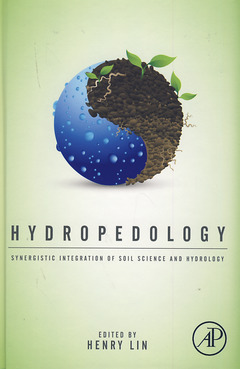Description
Hydropedology
Synergistic Integration of Soil Science and Hydrology
Coordinator: Lin Henry
Language: English
Subject for Hydropedology:
858 p. · 15x22.8 cm · Hardback
Description
/li>Contents
/li>Readership
/li>Biography
/li>Comment
/li>
Hydropedology is a microcosm for what is happening in Soil Science. Once a staid discipline found in schools of agriculture devoted to increasing crop yield, soil science is transforming itself into an interdisciplinary mulch with great significance not only for food production but also climate change, ecology, preservation of natural resources, forestry, and carbon sequestration. Hydropedology brings together pedology (soil characteristics) with hydrology (movement of water) to understand and achieve the goals now associated with modern soil science.
Part I Overviews and Fundamentals 1. Hydropedology: Addressing Fundamentals and Building Bridges to Understand Complex Pedologic and Hydrologic Interactions 2. Understanding Soil Architecture and Its Functional Manifestation across Scales 3. Preferential Flow in a Pedological Perspective 4. Preferential Flow Dynamics and Plant Rooting Systems 5. Redoximorphic Features as Related to Soil Hydrology and Hydric Soils 6. Subaqueous Soils: Pedogenesis, Mapping, and Applications 7. Quantifying Processes Governing Soil-Mantled Hillslope Evolution 8. Thermodynamic Limits of the Critical Zone and their Relevance to Hydropedology Part II Case Studies and Applications 9. Hydropedology in Caliche Soils Weathered from Glen Rose Limestone of Lower Cretaceous Age in Texas 10. Hydropedology in Seasonally Dry Landscapes: The Palouse Region of the Pacific Northwest USA 11. Hydropedology of the North American Coastal Temperate Rainforest 12. Hydropedology in the Ridge and Valley: Soil Moisture Patterns and Preferential Flow Dynamics in Two Contrasting Landscapes 13. Geophysical Investigations of Soil–Landscape Architecture and Its Impacts on Subsurface Flow 14. Hydropedology, Geomorphology, and Groundwater Processes in Land Degradation: Case Studies in South West Victoria, Australia 15. Hydropedology as a Powerful Tool for Environmental Policy and Regulations: Toward Sustainable Land Use, Management and Planning Part III Advances in Modeling, Mapping, and Coupling 16. Soil Information in Hydrologic Models: Hard Data, Soft Data, and the Dialog between Experimentalists and Modelers 17. Hydrological Classifications of Soils and their Use in Hydrological Modeling 18. Subsurface Flow Networks at the Hillslope Scale: Detection and Modeling 19. Hydrologic Information in Pedologic Models 20. Modeling and Mapping Soil Spatial and Temporal Variability 21. Digital Soil Mapping: Interactions with and Applications for Hydropedology 22. Coupling Biogeochemistry and Hydropedology to Advance Carbon and Nitrogen Cycling Science 23. Coupling Ecohydrology and Hydropedology at Different Spatio-Temporal Scales in Water-Limited Ecosystems 24. Hydropedology: Summary and Outlook
Scientists and practitioners; researchers, educators, students, and consultants interested in the interface of : soil science and hydrology, soil physics, geomorphology, biogeochemistry, geophysics, geology, ecology, natural resources, agricultural and biological engineering, civil and environmental engineering, and other related bio- and geo-sciences.
- The first book of its kind in the market
- Highly interdisciplinary, involving new thinking and synergistic approaches
- Stimulating case studies demonstrate the need for hydropedology in various practical applications
- Future directions and new approaches are present to advance this emerging interdisciplinary science




